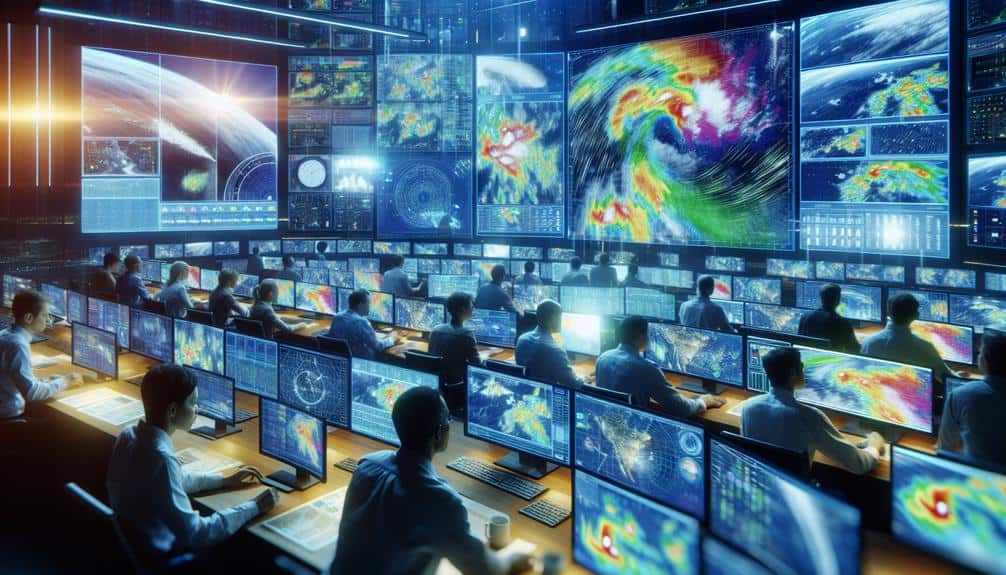Accurate storm prediction is vital because it allows us to utilize detailed meteorological data, advanced satellite imaging, and machine learning models to anticipate potentially devastating weather with precision. By analyzing temperature, humidity, wind patterns, and atmospheric pressure in real-time, we recognize the early signs of storm formation. Historical weather patterns enhance our predictions by highlighting recurring trends. Additionally, real-time updates fine-tune our models, enabling swift, informed decisions to protect lives and property. Investing in rigorous meteorological training guarantees experts can interpret this intricate data accurately. Join us to explore how these elements work together for truly reliable storm forecasts.
Key Points
- Accurate predictions ensure timely warnings, improving public safety and reducing potential damage from storms.
- Precision in forecasting storm paths aids in efficient allocation of emergency resources and planning.
- Accurate storm predictions minimize economic losses by informing businesses and governments for better preparedness.
- Real-time accurate updates enhance the reliability of predictive models, providing more precise storm trajectories and intensities.
Understanding Meteorological Data
To accurately predict storm formations, we must first analyze and interpret a wide range of meteorological data, including temperature, humidity, wind patterns, and atmospheric pressure. By examining these variables, we can identify the underlying weather patterns that lead to storm development. This data interpretation process is crucial for making informed predictions and ensuring public safety.
We start by collecting temperature data, which allows us to understand the thermal dynamics in the atmosphere. Temperature gradients often indicate potential areas of instability, which are precursors to storm activity. Humidity measurements help us assess moisture levels, essential for cloud formation and precipitation. High humidity levels in conjunction with specific temperature thresholds can signal the likelihood of storm development.
Wind patterns also play a significant role in storm prediction. By studying wind speed and direction at various altitudes, we can identify convergent zones where air masses meet and rise, forming storms. Atmospheric pressure readings provide additional insight; low-pressure systems are often associated with unsettled weather and storm potential.
Effective data interpretation provides us with the freedom to anticipate and respond to weather patterns accurately. This empowers communities to prepare adequately, minimizing the impact of severe weather events on lives and property.
Leveraging Advanced Technology
We'll enhance our storm prediction accuracy by integrating satellite imaging techniques, machine learning models, and real-time data analysis.
By leveraging high-resolution satellite data, we can monitor atmospheric changes with greater precision.
Machine learning algorithms allow us to identify patterns and predict storm formations more reliably and swiftly.
Satellite Imaging Techniques
Leveraging advanced satellite imaging methods, we can now predict storm formations with unparalleled precision and detail. These technologies allow us to monitor weather patterns on a global scale, offering a detailed view that was previously unattainable.
By capturing high-resolution images of the Earth's atmosphere, we can observe the development of storm systems from their early stages, enabling more precise storm tracking.
Satellites equipped with sophisticated instruments measure various atmospheric parameters, such as temperature, humidity, and wind speed. This data is essential for identifying the conditions that may lead to storm formation.
For example, infrared imaging helps detect temperature variations in cloud tops, which can indicate the presence of strong updrafts, a precursor to storm development. Additionally, radar-equipped satellites provide real-time updates on precipitation intensity and movement, enhancing our ability to forecast storm paths.
The integration of these imaging methods into our meteorological practices means we can issue more timely warnings, potentially saving lives and reducing economic losses. By constantly refining our satellite technology, we empower ourselves to act swiftly and decisively in the face of nature's most powerful forces.
Ultimately, this technological advancement supports our collective aspiration for greater safety and freedom.
Machine Learning Models
Building on the precise information gathered from satellite imaging, machine learning models analyze vast amounts of atmospheric data to predict storm formations with even greater precision. By leveraging advanced algorithms, we can process complex datasets to identify patterns that might be unnoticed through traditional methods.
The first step in this process is data preprocessing, where we clean, normalize, and transform raw data into a structured format suitable for analysis. This guarantees that our models operate on high-quality inputs, minimizing errors and biases.
Once the data is preprocessed, we train our machine learning models using historical storm data and meteorological variables. These models learn to recognize the detailed relationships between various atmospheric factors, such as temperature, humidity, and wind speed.
Model evaluation is important here; we assess performance using metrics like accuracy, precision, and recall to secure our predictions are reliable.
Real-time Data Analysis
By integrating real-time data analysis, we enhance our ability to monitor and predict storm formations with exceptional accuracy. This is achieved through leveraging advanced technology, which allows us to process vast amounts of atmospheric data instantaneously.
Real-time data analysis involves continuous data streams from satellites, weather stations, and ocean buoys, giving us a detailed view of current weather conditions.
Data visualization plays an important role in this process. By converting raw data into graphical representations, we can quickly identify patterns and anomalies that might indicate the early stages of storm formation. Predictive analytics further refines our forecasts by using historical data and current trends to model potential storm trajectories and intensities.
Here are three key benefits of real-time data analysis in storm prediction:
- Immediate Response: Real-time data allows for quick decision-making, enabling us to issue timely warnings and take preventive measures.
- Improved Accuracy: Continuous updates enhance the precision of our predictions, reducing the margin of error.
- Resource Optimization: By predicting storm paths more accurately, we can allocate resources efficiently, minimizing economic and human impact.
Incorporating real-time data analysis not only empowers us with better tools but also aligns with our desire for freedom and safety in the face of natural disasters.
Importance of Real-Time Updates

Immediate updates are vital in storm prediction because they allow meteorologists to analyze the most current data and refine their models for greater precision. With real-time monitoring, we're able to track storm developments minute-by-minute, giving us a dynamic and ever-evolving picture of atmospheric conditions. This immediate access to data empowers us to make precise adjustments to predictive models, enhancing our ability to forecast storm paths and intensities with remarkable accuracy.
In the field of emergency response, real-time updates are invaluable. They enable authorities to make informed decisions swiftly, making sure that evacuation orders and safety measures are based on the latest and most reliable information. This timeliness is essential for preserving lives, minimizing property damage, and maintaining public safety. By leveraging real-time data, we can issue more accurate warnings, refine emergency plans, and deploy resources more effectively.
Furthermore, the ability to continuously update predictive models with real-time data ensures that any changes in storm behavior are promptly reflected. This adaptability is crucial for managing the inherent uncertainties in weather forecasting, offering us the freedom to respond proactively rather than reactively.
Essentially, real-time updates are the foundation of modern meteorology, driving both accuracy and effective emergency management.
Role of Historical Weather Patterns
When we analyze past trends, we can identify recurring patterns that greatly enhance our storm prediction models.
Historical weather data provides a strong foundation for understanding storm formation dynamics.
Analyzing Past Trends
To enhance our accuracy in predicting storm formations, we must rigorously analyze historical weather patterns to identify consistent trends and anomalies. By examining past data, we can employ statistical analysis and predictive modeling to better forecast future storm behaviors. Our approach is rooted in analyzing three important factors:
1. Statistical Analysis:
By examining decades of historical weather data, we can pinpoint the conditions that typically precede storm formations. This involves identifying correlations and causations that offer insights into storm genesis.
2. Predictive Modeling:
Utilizing advanced algorithms and machine learning, we can create models that simulate various weather scenarios. These models, grounded in historical data, allow us to predict storm formations with greater precision.
3. Climate Change and Extreme Weather:
As climate change continues to influence weather patterns, understanding its impact on storm formation becomes essential. Historical data reveals how increasing temperatures and shifting atmospheric dynamics contribute to more frequent and severe storms.
Identifying Recurring Patterns
By scrutinizing past weather events, we can identify recurring patterns that greatly enhance our predictive capabilities for storm formations. When we analyze historical data, pattern recognition becomes a powerful tool in weather forecasting. We can detect trends that indicate the likelihood of storm development, enabling us to make more accurate predictions.
For example, by examining decades of meteorological data, we can see how certain atmospheric conditions, such as sea surface temperatures and wind patterns, tend to precede major storms. These patterns aren't random; they follow specific, identifiable sequences that, once recognized, allow us to forecast future storms with greater precision.
Our ability to recognize these patterns is vital for improving the accuracy of weather forecasting models. It allows us to anticipate storm formations days, or even weeks, in advance. This predictive power is invaluable, giving communities more time to prepare and potentially saving lives.
Incorporating pattern recognition into our weather forecasting arsenal isn't just about improving accuracy; it's about empowering people with the knowledge they need to make informed decisions. By understanding the recurring patterns in weather, we can better navigate the uncertainties of nature, ensuring we're both prepared and free to act.
Training and Expertise Required

How important is the rigorous training and extensive expertise required for meteorologists to accurately predict storm formations? It's absolutely crucial. Forecasting techniques demand a deep reservoir of expert knowledge and proficiency in interpreting complex weather data. This expertise is built over years of education and practical experience, enabling meteorologists to employ proven methods with precision and reliability.
Meteorologists undergo rigorous training that includes:
- Advanced Education: Most meteorologists hold at least a bachelor's degree in meteorology or atmospheric science, with many pursuing master's or doctoral degrees to deepen their understanding of forecasting techniques and scientific principles.
- Field Experience: Hands-on experience in various weather conditions equips meteorologists with the practical skills necessary to interpret real-time data and recognize subtle atmospheric changes.
- Continuous Learning: Weather patterns and forecasting models evolve, requiring meteorologists to stay updated through ongoing training and professional development.
Our freedom to make informed decisions, especially in the face of severe weather, hinges on the accuracy of these forecasts. Experienced professionals utilize their expert knowledge and proven methods to deliver reliable predictions, ensuring we're well-prepared for any storm that comes our way. Without such rigorous training and expertise, the precision and trustworthiness of storm predictions would be significantly compromised.
Impact on Public Safety
Accurate storm predictions play a critical role in safeguarding public safety by enabling timely evacuations and preparations. When meteorological data is precise, we can predict storm paths and intensities with greater confidence, allowing communities to take necessary precautions. For instance, reliable forecasts can activate emergency preparedness plans, ensuring that resources like food, water, and medical supplies are readily available.
Public awareness campaigns can then disseminate essential information, guiding individuals on how to protect themselves and their property. Data shows that improved storm prediction accuracy can reduce fatalities and injuries. According to a study by the National Oceanic and Atmospheric Administration (NOAA), areas with early and accurate storm warnings saw a 30% decrease in weather-related casualties. This statistic underscores the importance of having robust prediction systems in place.
Additionally, accurate forecasts minimize economic losses by allowing businesses to secure assets and continue operations with minimal disruption. We must advocate for better predictive technologies and training for meteorologists to maintain and elevate our current standards. By prioritizing accuracy in storm predictions, we're not just mitigating immediate dangers but also fostering a culture of preparedness and resilience. This enables us to live freely, knowing we've the tools to face natural disasters head-on.
Frequently Asked Questions
How Do Storm Predictions Affect Economic Activities?
Storm predictions heavily impact economic activities. Accurate forecasts and their reliability enable businesses to make informed decisions, minimizing risks and economic implications. Ensuring precision in weather data safeguards investments and maintains economic stability amidst potential disruptions.
What Are the Psychological Impacts of Inaccurate Storm Forecasts?
Inaccurate storm forecasts greatly affect mental health, increasing anxiety and reducing preparedness. Our trustworthiness in weather systems diminishes, leading to potential neglect of future warnings. Data indicates this can undermine community resilience and individual freedom.
Can Storm Predictions Influence Insurance Policies and Rates?
Did you know that accurate storm predictions can reduce insurance premiums by up to 25%? Storm predictions directly influence insurance impacts, with policy changes reflecting risk assessments, ultimately affecting our financial freedom and security.
How Do Inaccuracies in Storm Predictions Impact Agricultural Planning?
Inaccuracies in storm predictions create significant agricultural impacts and planning challenges. We can't effectively safeguard crops or allocate resources efficiently, leading to potential economic losses and food supply disruptions. Precision in forecasting is essential for optimizing our agricultural strategies.
What Role Do Public Communication Strategies Play in Storm Prediction Accuracy?
In the storm prediction arena, public communication strategies are the linchpin. They bolster public trust and sharpen emergency response. Clear, data-driven updates guarantee we're all on the same wavelength, safeguarding our freedom and preparedness.


